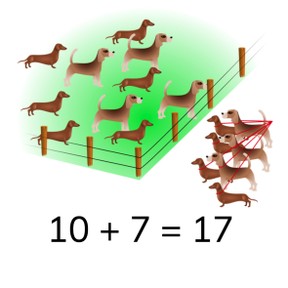8,000 schools use Gynzy
92,000 teachers use Gynzy
1,600,000 students use Gynzy
General
Students learn to match an image to an addition problem with numbers up to 20.
Introduction
Set a few blocks on the table at the front of the class (maximum of 20). Ask students to come to the front and ask how many blocks are on the table. Repeat this with pencils. Show the cups on the interactive whiteboard and ask the class to count how many there are. Ask students if there are tricks or ways to count that are easier than counting one by one. Say that you can cross off the objects as you count them. Then count the rugby balls.
Development
Show the bead chain on the interactive whiteboard. A few beads are already on the chain, and there are also loose beads. First count the beads that are on the chain, and then the loose beads. You count on with the loose beads. There are 11 beads on the chain and 9 loose beads. This is 11+9. Next, show 12 beads on a chain and 3 loose beads. This is 12+3. Discuss all variations of the beads on chains and show the students the addition problems that they represent. Next, show the squirrel with acorns. Say that you first count the 9 acorns that the squirrel already has, and then the 10 acorns that are on the ground. Make sure to point out that the + sign means addition and says that the two things will be combined. Say that the first addend in the addition problem is what you have and that the second addend is what is being added to what you already have. Next, show a cake that is being decorated with strawberries. Ask the students if they can determine the addition problem represented by the image. Erase the grey box to check their answer. On the next page, students are asked to drag the coins to the piggy bank to match the image to the addition problem.
Using the baby chicks, explain that if you know the addition problem, you can also solve for the sum or total by counting the two addends together. Practice this with the pencils by having students first find the addition problem, and then solving it. Repeat this with the image of flowers.
Check that students understand recognizing addition problems to 20 by asking the following questions:
- How do you know which numbers make up an addition problem?
- What do you do if you want to know the total of both groups of objects?
- How do you know what the first addend in an addition problem is?
- What does the second addend mean in an addition problem?
Guided practice
Students first practice recognizing addition problems from provided answers in multiple-choice. Then they must match the image to a given addition problem. Finally, they must give the addition problem as well as solve the problem.
Closing
Discuss with students that it is important to be able to recognize addition problems up to 20, so you can learn how to add. Next ask a student to come to the front of the class and secretly show them an abstract addition problem. Ask them to draw an image/objects to match the shown addition problem. They can draw circles, squares, butterflies, flowers, or more. Make sure that the student makes a clear division between the group representing the first addend and the group representing the second addend. After the student has finished drawing, then ask the class if they can determine what the addition problem is, and then solve for the sum.
Teaching tips
Students who have difficulty adding using images can be supported by the use of manipulatives like MAB-blocks. Have them set one group of manipulatives to the left, the other to the right, and then to count the objects one by one.
Instruction materials
blocks and pencils
The online teaching platform for interactive whiteboards and displays in schools
Save time building lessons
Manage the classroom more efficiently
Increase student engagement
Discover more!
About Gynzy
Gynzy is an online teaching platform for interactive whiteboards and displays in schools.
With a focus on elementary education, Gynzy’s Whiteboard, digital tools, and activities make it easy for teachers to save time building lessons, increase student engagement, and make classroom management more efficient.







